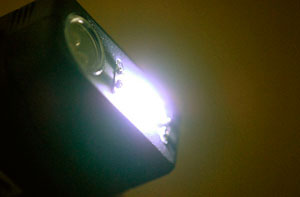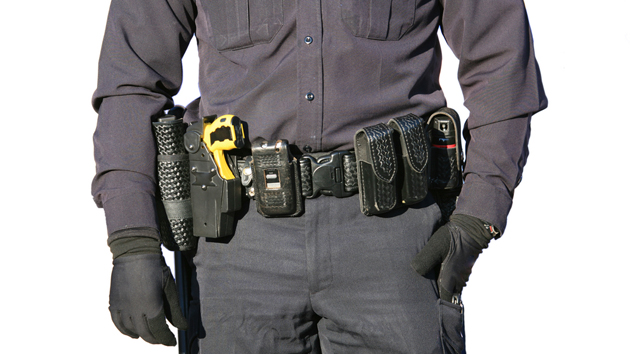
Photo courtesy of flickr user <a href="http://www.flickr.com/photos/hermanturnip/3265381575/" target="blank">hermanturnip</a>
This story first appeared at Alternet.
One spring day this April, at the Franklin Correctional Institution on Florida’s Highway 67, Sgt. Walter Schmidt pulled out his Electronic Immobilization Device — EID in officer parlance — and zapped two people, who immediately “yelped in pain, fell to the ground and grabbed red burn marks on their arms,” according to the St. Petersburg Times.
The two were not inmates at the prison, however. They were students visiting the facility as part of “Take Our Daughters and Sons To Work Day.”
The move cost Sgt. Schmidt his job, despite his claim that he merely intended to demonstrate how the devices worked. He even asked the children’s parents (who were also employees at the prison) permission first. “When they said ‘sure,’ I went ahead and did it,” he told the Times.
“It wasn’t intended to be malicious, but educational. The big shock came when I got fired.”
Schmidt wasn’t alone in his job-costing blunder. In fact, it came just one day after multiple children, visiting different prisons were similarly shocked.
“A total of 43 children were directly and indirectly shocked by electric stun guns during simultaneous Take Your Sons and Daughters to Work Day events gone wrong at three state prisons last month,” reported the St. Petersburg Times on May 16th. “One was a warden’s daughter.”
Their ages ranged from five to 17. Fourteen of the kids were “directly shocked.” The other 29 were “indirectly exposed when they held hands with a person who was shocked. With the kids circled together, the electricity could flow from one child’s hands to the next.”
Walt McNeil, Secretary of the Florida Department of Corrections told the Times, “I can’t imagine what these officers were thinking to administer this device to children, nor can I imagine why any parent would allow them to do so. This must not happen again.”
The bizarre rash of student electrocutions might have been an aberration on Florida prison grounds, but the guards — three of whom were fired and two of who resigned — might be forgiven for assuming that such devices are somehow safe for kids. Even as news outlets across the country report episode after episode where police officers tase and use stun guns on unlikely people — take the pregnant woman tased at a baptism in Virginia or the 72-year-old woman tased in a Texas traffic stop — more and more police officers are being given tasers to carry into schools.
And not just college campuses; middle and high schools across the country are inviting Taser-toting cops on school grounds.
This comes at a time when Tasers have claimed the lives of hundreds of people, including three teenagers this year alone. While heightened security might be a necessity in an age where kids smuggle deadly weapons to school, this fact alone should give parents and school officials pause. Even as school administrators and local law enforcement accept and incorporate Tasers as disciplinary measures, deploying them on school grounds is putting students at risk.
Is Breaking School Rules A Crime?
Last September, police officers in Hawthorne, CA tased an autistic 12-year-old boy at his middle school after he became “violent,” launching a misconduct investigation by the police department. In June, at Penn Hills High School in Pennsylvania, a student was tased in the hallway after ignoring a police officer’s orders to put away his cell phone. (“The kid refused to listen,” Penn Hills Police Chief Howard Burton explained, saying the student then “pushed the officer.”)
In 2006, an 11th grader named Angel Debnam was tased at her high school in Bunn, North Carolina, just outside Raleigh. “Something sticks in you, and it’s like a wire,” Debnam described to local ABC affiliate WTVD. (“When I was on the ground crying and shaking, he asked me, ‘Was that enough? Are you calmed down now?’ and he did it again.”)
In March, the Los Angeles Times reported that “the number of law enforcement agencies that have given Tasers to officers who work on school campuses has grown to well over 4,000,” according to Steve Tuttle, Vice President of Communications at Taser International. That’s up from 1,700 in 2005.
In an e-mail to AlterNet last week, Tuttle said that this estimate remains accurate, noting that it “includes municipal law enforcement agencies that have School Resource Officers (SROs) for elementary and high schools, as well campus police for colleges and universities.” But Tuttle took issue with the notion that Tasers are used “‘for unruly students’ as the LA Times article inferred.”
“They are used to protect students and faculties,” he said, as well as police officers hired to patrol school grounds.
Just weeks into the 2009/2010 school year, at least one report has surfaced of a student being tased on school grounds. In Topeka, Kansas, a teenager at Capital City School was sent to the hospital after being tased, reportedly after “attacking” a school police officer while a Topeka police officer handcuffed him. (According to local media, the student “was being suspended for violating school rules.”)
“Our premier law enforcement electronic control device”
Last fall, police officers patrolling Duval County Public Schools in Jacksonville, Fl joined the ranks of school security officers who carry Tasers on campus. The decision followed years of controversy over the measure, which was first announced in 2005.
That January, local press reports revealed that the Jacksonville Sheriff’s Office (JSO) had signed a $1.8 million contract with Taser International to buy 1,800 Taser guns for city police officers over the next two years, some of which would be used by school security officers. The timing was at least partly motivated by Superbowl XXXIX, which was held at Jacksonville Municipal Stadium that February.
According to the Associated Press, “some school officials [were] surprised by the action, saying they were never told by the Jacksonville Sheriff’s Office that it planned to issue stun guns to the officers assigned to most middle and high schools.”
But plans to deploy the Tasers were put on hold shortly after. In late February 2005, Sheriff John Rutherford imposed a blanket moratorium on Taser use by the JSO after it came under fire for the repeated tasing of a 13-year-old, 65 lb girl who was in handcuffed inside a patrol car.
Llahsmin Lynn Kallead had reportedly kicked the inside of the police car when she was shocked multiple times by her arresting officer.
“I saw her jump from one side of the police car to the other” from the shock, her mother, Rosie Vaughan, told reporters. “She shook.”
It was surely a PR nightmare for Sheriff Rutherford, who had gone to great lengths to prove the safety and usefulness of the devices, holding town hall meetings across the county on the topic. The stocky 52-year-old had even volunteered to be tased himself, on camera, to demonstrate. (“Rutherford took a hit in the back and fell to the floor as other officers held his arms,” according to Jacksonville’s News 4. “He bounced back up almost immediately, saying, ‘There you have it.'”
In a conversation with AlterNet, the sheriff’s office preferred to refer to Tasers by the name the company gives them: “Electronic Control Devices” or ECDs. An JSO employee told AlterNet, “we were, obviously, very thorough and deliberative in making sure that they fit in our use-of-force matrices.”
For the JSO, the main value of the Taser is that “it enables the officer to bring someone under control.”
This apparently includes students and other hard-to-handle populations. Not only are the devices deployed in all the middle and senior high schools in Jacksonville, according to the Sheriff’s office, “we’ve also had many incidents where a mentally impaired person was brought under control through the use of the ECD.”
The model used in Jacksonville schools is the TASER X26, which, unlike those used by the police officer who tased the kids on “Take Our Daughters and Sons To Work Day” can be fired remotely, hitting targets as far as 35 feet away with 50,000 volts of electricity. Taser International describes the X26 model as “our premier law enforcement electronic control device.”
A “Non-Lethal” Weapon That Has Killed Hundreds
In December 2008, Amnesty International released a 130-page report titled “Less Than Lethal? The Use of Stun Weapons in U.S. Law Enforcement,” which found that 334 people had died after being tased since 2001. (This figure is already obsolete.) The vast majority of these deaths were due to cardiac or respiratory arrest. Of the 334 victims, 299 of them were unarmed.
The state with the most recorded Taser deaths was California, with 55. Florida ranked second, with 52.
The victims were mostly adults, but they also included teenagers, like 17-year-old Darryl Turner, who “collapsed shortly after being shocked for 37 seconds in the chest.” According to the autopsy, a “lethal disturbance” of his heart rhythm was “precipitated by the agitated state and associated stress as well as the use of the conducted energy weapon.” According to Amnesty, “the coroner also noted that there were no anatomic findings indicating a pre-existing cardiac abnormality or disease, and no illegal drugs in his system.”
The first three reported deaths by Taser in 2009 all involved teenage victims. In January, 17-year-old Derick Jones of Martinsville, Virginia died after a police officer responded to a complaint about public urination by chasing him into a house and tasing him when the boy “moved rapidly” toward him. In the spring, two teenage boys in Michigan died within weeks of one another after being tased by police officers, 15-year-old Brett Elder, and 16-year-old Robert Mitchell. In both cases, police accused the teens of resisting arrest.
Elder’s father, Eugene, acknowledged that his son, who was days away from his 16th birthday, might have been confrontational. Still, he told the Bay City Times. “There’s no reason to kill my boy.”
“[The police] are here to protect us,” Renea Mitchell, Robert Mitchell’s mother told CNN. “There’s no reason for what they’ve done,” she said. “There’s no reason, no excuse.”
Taser critics have long pointed out that the devices are marketed as non-lethal despite a lack of independent data — and considerable anecdotal evidence to the contrary. According to Amnesty, “the only medical safety studies prior to the marketing of the Advanced M26 Taser in late 1999 were animal tests conducted for Taser International to see whether the device could cause ventricular fibrillation in a pig and three dogs.”
Even those conclusions have been challenged in recent years. In a study carried out by a team of doctors and scientists at Chicago’s Cook County hospital in 2006, 11 unfortunate pigs were shocked with Taser guns — researchers tased them multiple times, in 40 second increments — to devastating effect. “When the jolts ended, every animal was left with heart rhythm problems, the researchers said. Two of the animals died from cardiac arrest, one three minutes after receiving a shock.”
Some have argued that pigs aren’t reliable testing subjects. (“In my modeling, I prefer to use humans,” Dr. Jeffry Ho, an associate professor of emergency medicine at the University of Minnesota told the Canadian Broadcasting Corporation. ) This includes Taser International’s co-founder, Rick Smith, who has argued that pigs weigh less than 100 pounds and “have a very different physiology from humans,” according to CBC News — an argument that would seem to undermine the company’s own research techniques.
In March 2005, a report by the (rather bizarrely named) Human Effects Center of Excellence at Brooks Air Force Base, which tests and “non-lethal” weapon technology, found “a large margin of safety with the ‘normal X26 operating output’ in the case of large children and adults,” according to Amnesty. The study’s authors, who based their research primarily on data provided to them by Taser International, also reviewed other studies, including “tests investigating the effects of Tasers on the hearts of pigs weighing between 30 and 117 kilograms.” They found that the more a pig weighed, the less potential risk there was for internal injury. “These tests have been interpreted to conclude that smaller individuals (e.g. children) may be more susceptible to adverse effects from Taser shocks,” according to Amnesty.
In 2007, the UK’s Defense Scientific Advisory Council Sub-Committee on the Medical Implications of Less-Lethal Weapons (DOMILL) concluded that although there is “very limited information globally on the relative vulnerability of children to Tasers,” existing data suggest that “the safety factor for induction of ventricular fibrillation by Taser discharge in children at the younger (i.e. smaller) range of the pediatric population may be lower compared with that in the adult population.” In other words, the smaller the child, the less voltage it takes to hurt them.
“Until more research is undertaken to clarify the vulnerability of children to Taser currents,” the study concluded, “children and persons of small stature should be considered at possible greater risk than adults.”
Playing With Fire
Reports of children who have died after being tasered may mainly tell the stories of teenagers, but, along with an apparent misunderstanding of the sheer force of Tasers and stun guns (at least if the Take Your Children to Work Day fracas is any indication), the already heavy-handed approach to students as young as seven in some schools suggests that arming police officers with Tasers might invite dangerous scenarios.
Take, for example, police in Avon Park, FL, who handcuffed and arrested a seven-year-old girl named Desre’e Watson, when she threw a tantrum in her kindergarten class. Or cops in Detroit this past June, who handcuffed a fourth grader and special ed student to the door of his principal’s office for four hours . If teachers, administrators, and police have resorted to such measures to get a handle on unruly children won’t adding Tasers to the equation up the risk factor?
In an era that sees students standing in line to go through metal detectors before homeroom, there’s no question that weapons in school require reliable school security. Arming school security officers with “non-lethal” weapons might seem to be a good solution. That is, if Tasers actually fit the bill.
















